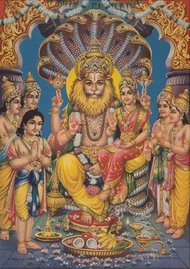He shares the paanagam with His devotee
| In Andhra Pradesh is located over 30 temples of Lord Narasimha in fascinating forms. |

Sri Lakshminarasimha with Consort at Mattapalle. Pic courtesy M. N. Srinivasan.
"NARASIMHASWAMY PANAKALA thagutaru...!" the local residents excitedly tell visitors. As one leans back to view the 400 steps that lead to the temple, in the sweltering heat, it seems a formidable task. As though they have read one's mind doli bearers offer their services to carry one up literally on their shoulders. Swetadri, Dharmadri, Thothadri, Mangalagiri...these are the various names for Panakala Narasimha Swamy established on a reclining elephant shaped hillock about 260 metres above sea level at a place called Mangalagiri, close to Vijayawada, Andhra Pradesh. Panakala Narasimha Swamy, one of the 32 Narasimha kshetras of Andhra Pradesh creates awe in devotees present, for the deity actually drinks panakala or jaggery water poured into its mouth that is an opening in the rock about 15cm wide. The face of the Lord is a formation on the rock that resembles Narasimha and traditionalists aver that the Lord here is self-manifest. The Deeparadhana reveals, on the inner wall of the cave, a formation symbolic of the Sudarshana Chakra. As the Paanagam from the conch flows down the throat of the Lord it is quite intriguing to hear a gurgling noise. What is more, the Lord is always satisfied with half the paanagam offered to him, the other half left for the devotee. Narasimha also seems to have stipulated his preference for each of the four yugas. Thus it was honey in the Kritayuga, milk in the Treta, ghee in the Dwapara and Paanagam in the Kali yuga. Modernists, however, explain this phenomenon saying that the hillock was originally a volcano and jaggery water neutralises the sulphur compounds found in the volcano and prevents an eruption. A drop of honey, a saying goes, attracts a thousand flies. But for all the sticky sweet water that almost glues one's foot to the floor, a remarkable feature is the relative absence of flies in the area where the paanagam is made. According to historians this temple belongs to the period prior to 300 BC. Ancient scriptures, in particular the ``Brahmavaivarta Purana," refer to this shrine. The Kshetra Purana says that Vishnu in his fourth avatar as Narasimha killed the demon king Namuchi. The blood from his body flowed into a canal. This came to be called the Rakta Kulya. Of course, the canal is now dry. Another story goes that a prince Hrshya Shringi, son of King Pariyathra, did penance here and transformed himself into an elephant shaped hill so that his body might serve as the abode of Lord Narasimha. Inscriptions record this hillock as originally having the name of Hasta giri or Elephant Mount. The Satavahanas, Ikshvakus Kakatiyas and Krishnadevaraya of Vijayanagar made a lot of improvements to this temple. The hillock also bears the footprints of Sri Krishna Chaitanya Mahaprabhu who visited this place in 1310 A.D.
In the 18th century, Raja Vasi Reddy Venkatadri Naidu of Amaravati constructed a stupendous tower on the eastern gate of the lower temple. This 47-metre high tower dwarfs the central shrine and serves as a landmark for that area. To the side of the main temple is another one dedicated to Sri. A chariot or ratha, belonging to the Narasimha temple, is made of wood and displays exquisite carvings of many stories drawn from the epics and the Bhagavata.
At the Narasimha shrine at the ground level, aptly called Kizh Mangalagiri, is a nice shrine of the Lord. No, he doesn't perform any miracles, but on request the priest brings out the collection of saligramas many amazingly similar to the avataras of Vishnu.
Sighs and exhalations, it seems is just not confined to humans as the Narasimha temple in Vadapally demonstrates. Vadapally, in Nalgonda district, is situated where the rivers Krishna and Muchikunda and the Moosi merge. An absolutely amazing feature about this temple is the presence of two oil lamps on a stand fixed one below the other at a distance of approximately half a foot. The lighted wick of the lamp at the top gently flickers while the bottom wick stands motionless. Tradition goes that the top wick flickers because of the exhalation of the Lord. (A Siva temple in the vicinity displays an interesting Sivalinga. A hole in it is always filled with water. When the water is taken out, it replenishes itself again.) Mattapalle is a swayamvakta kshetram — it is said to have appeared on its own. The sanctum sanctorum is in a cave. The main deity, Narasimha, is a formation on the walls of the cave. One is also shown a rock formation that resembles Mahavishnu on Adisesha and is behind the main deity. Story goes that the Lord appeared in the dream of Anumula Machi Reddy and directed him to look for him nearby. On searching in the vicinity Reddy found this cave. Later on a temple was constructed in this site outside the cave.


